technical specifications FIAT STILO 2006 1.G Owners Manual
[x] Cancel search | Manufacturer: FIAT, Model Year: 2006, Model line: STILO, Model: FIAT STILO 2006 1.GPages: 274, PDF Size: 4.76 MB
Page 135 of 274

134
CORRECT USE
OF THE CAR
WARNING
LIGHTS AND
MESSAGES
IN AN
EMERGENCY
CAR
MAINTENANCE
TECHNICAL
SPECIFICATIONS
IINDEX
DASHBOARD
AND CONTROLS
SAFETY
DEVICES
When the ignition key is
turned to MAR, the warning
light
F(with passenger’s front air
bag deactivation switch at ON) turns
on and flashes for few seconds to re-
mind that the passenger’s air bag will
be deployed in a crash, after which
it should go off.
WARNING
When the ignition key is
turned to MAR, the warning
light
À(with the rear side bag de-
activation switch at ON) turns on and
flashes for few seconds to remind that
the rear side bags will be deployed in
a crash, after which it should go off.
WARNING
Do not wash the seat back
rest with pressurised water
or steam (by hand or at automatic
seat washing stations).
WARNING
The front air bag is triggered
for shocks greater in magni-
tude than the pretensioners. For im-
pacts between these two thresholds,
it is therefore normal that only the
pretensioners are triggered.
WARNING
Do not hook rigid objects to
the coat hooks and to the
support handles.
WARNING
The air bag does not substi-
tute the seat belts, but only
increases their effectiveness. More-
over, since the front air bags do not
come into operation in the event of
front impact at low speed, side colli-
sions, bumps from behind or over-
turning, in these circumstances the
occupants would only be protected
by the seat belts which must therefore
always be fastened.
WARNING
Page 136 of 274
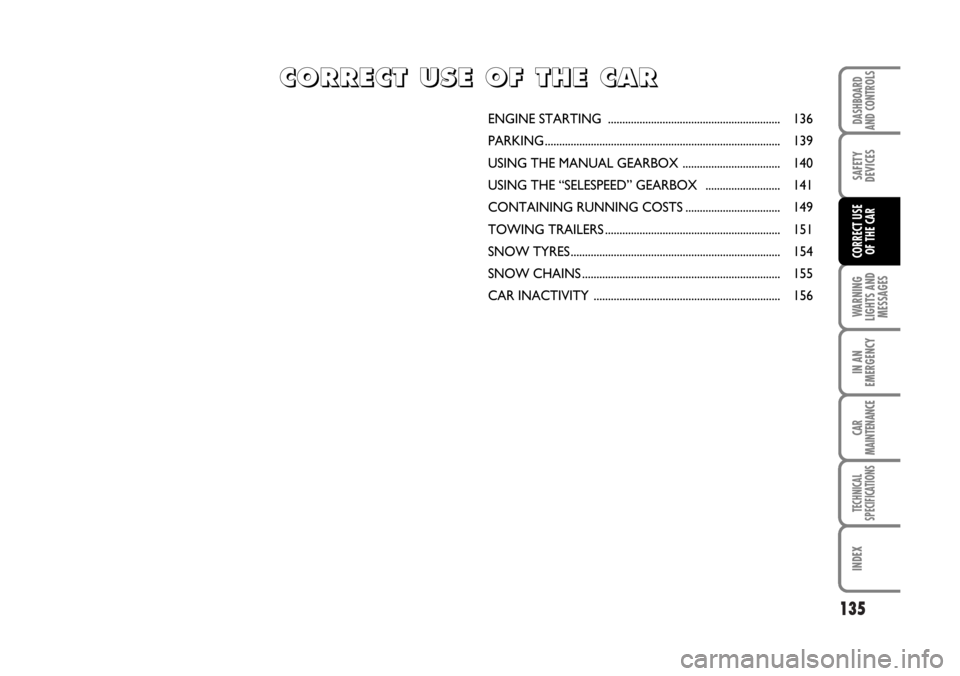
135
WARNING
LIGHTS AND
MESSAGES
IN AN
EMERGENCY
CAR
MAINTENANCE
TECHNICAL
SPECIFICATIONS
INDEX
DASHBOARD
AND CONTROLS
SAFETY
DEVICES
CORRECT USE
OF THE CAR
ENGINE STARTING ............................................................ 136
PARKING .................................................................................. 139
USING THE MANUAL GEARBOX .................................. 140
USING THE “SELESPEED” GEARBOX .......................... 141
CONTAINING RUNNING COSTS ................................. 149
TOWING TRAILERS ............................................................. 151
SNOW TYRES ......................................................................... 154
SNOW CHAINS ..................................................................... 155
CAR INACTIVITY ................................................................. 156
C C
O O
R R
R R
E E
C C
T T
U U
S S
E E
O O
F F
T T
H H
E E
C C
A A
R R
Page 137 of 274
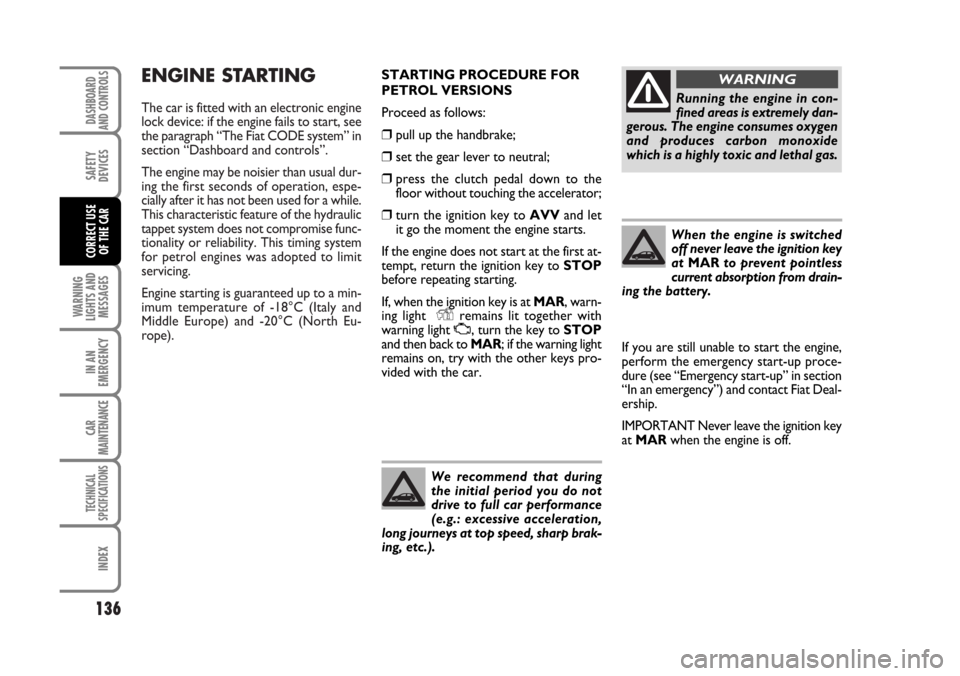
ENGINE STARTING
The car is fitted with an electronic engine
lock device: if the engine fails to start, see
the paragraph “The Fiat CODE system” in
section “Dashboard and controls”.
The engine may be noisier than usual dur-
ing the first seconds of operation, espe-
cially after it has not been used for a while.
This characteristic feature of the hydraulic
tappet system does not compromise func-
tionality or reliability. This timing system
for petrol engines was adopted to limit
servicing.
Engine starting is guaranteed up to a min-
imum temperature of -18°C (Italy and
Middle Europe) and -20°C (North Eu-
rope).
136
WARNING
LIGHTS AND
MESSAGES
IN AN
EMERGENCY
CAR
MAINTENANCE
TECHNICAL
SPECIFICATIONS
INDEX
DASHBOARD
AND CONTROLS
SAFETY
DEVICES
CORRECT USE
OF THE CAR
STARTING PROCEDURE FOR
PETROL VERSIONS
Proceed as follows:
❒pull up the handbrake;
❒set the gear lever to neutral;
❒press the clutch pedal down to the
floor without touching the accelerator;
❒turn the ignition key to AVVand let
it go the moment the engine starts.
If the engine does not start at the first at-
tempt, return the ignition key to STOP
before repeating starting.
If, when the ignition key is at MAR, warn-
ing light
Yremains lit together with
warning light U, turn the key to STOP
and then back to MAR; if the warning light
remains on, try with the other keys pro-
vided with the car.
We recommend that during
the initial period you do not
drive to full car performance
(e.g.: excessive acceleration,
long journeys at top speed, sharp brak-
ing, etc.).
Running the engine in con-
fined areas is extremely dan-
gerous. The engine consumes oxygen
and produces carbon monoxide
which is a highly toxic and lethal gas.
WARNING
When the engine is switched
off never leave the ignition key
at MARto prevent pointless
current absorption from drain-
ing the battery.
If you are still unable to start the engine,
perform the emergency start-up proce-
dure (see “Emergency start-up” in section
“In an emergency”) and contact Fiat Deal-
ership.
IMPORTANT Never leave the ignition key
at MARwhen the engine is off.
Page 138 of 274
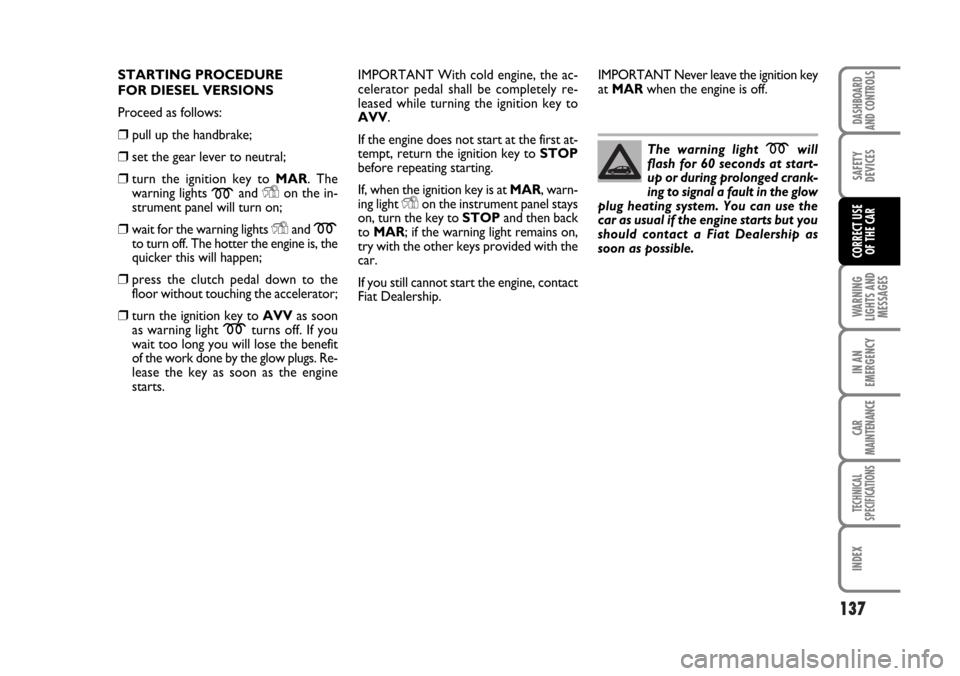
137
WARNING
LIGHTS AND
MESSAGES
IN AN
EMERGENCY
CAR
MAINTENANCE
TECHNICAL
SPECIFICATIONS
INDEX
DASHBOARD
AND CONTROLS
SAFETY
DEVICES
CORRECT USE
OF THE CAR
STARTING PROCEDURE
FOR DIESEL VERSIONS
Proceed as follows:
❒ pull up the handbrake;
❒set the gear lever to neutral;
❒turn the ignition key to MAR. The
warning lights
mand Yon the in-
strument panel will turn on;
❒wait for the warning lights Yand mto turn off. The hotter the engine is, the
quicker this will happen;
❒press the clutch pedal down to the
floor without touching the accelerator;
❒turn the ignition key to AVVas soon
as warning light mturns off. If you
wait too long you will lose the benefit
of the work done by the glow plugs. Re-
lease the key as soon as the engine
starts.IMPORTANT Never leave the ignition key
at MARwhen the engine is off.
The warning light
mwill
flash for 60 seconds at start-
up or during prolonged crank-
ing to signal a fault in the glow
plug heating system. You can use the
car as usual if the engine starts but you
should contact a Fiat Dealership as
soon as possible.
IMPORTANT With cold engine, the ac-
celerator pedal shall be completely re-
leased while turning the ignition key to
AVV.
If the engine does not start at the first at-
tempt, return the ignition key to STOP
before repeating starting.
If, when the ignition key is at MAR, warn-
ing light
Yon the instrument panel stays
on, turn the key to STOPand then back
to MAR; if the warning light remains on,
try with the other keys provided with the
car.
If you still cannot start the engine, contact
Fiat Dealership.
Page 139 of 274
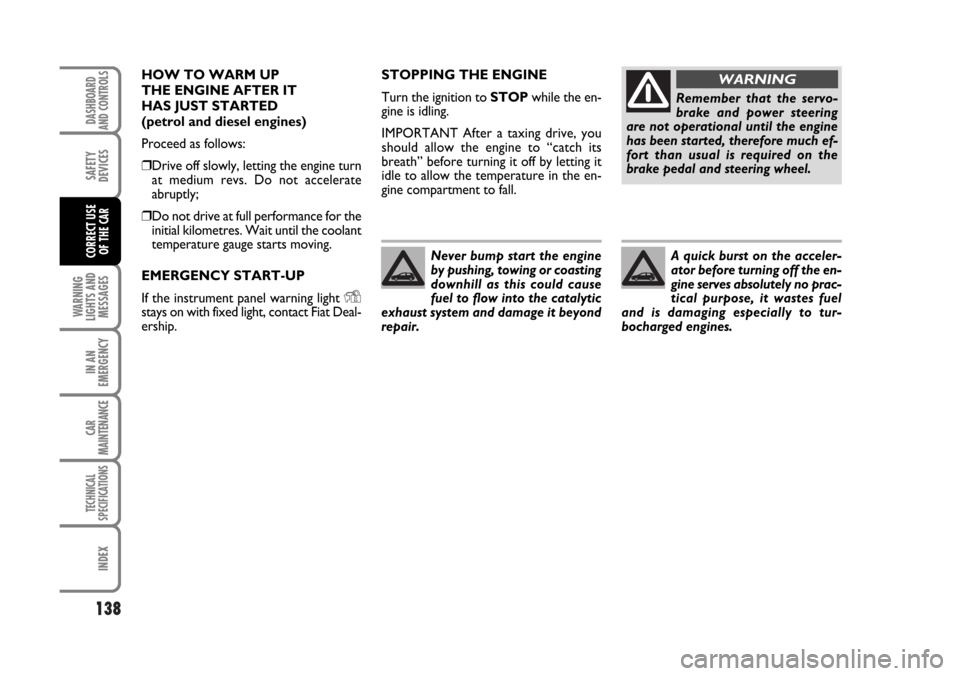
138
WARNING
LIGHTS AND
MESSAGES
IN AN
EMERGENCY
CAR
MAINTENANCE
TECHNICAL
SPECIFICATIONS
INDEX
DASHBOARD
AND CONTROLS
SAFETY
DEVICES
CORRECT USE
OF THE CAR
STOPPING THE ENGINE
Turn the ignition to STOPwhile the en-
gine is idling.
IMPORTANT After a taxing drive, you
should allow the engine to “catch its
breath” before turning it off by letting it
idle to allow the temperature in the en-
gine compartment to fall.
Never bump start the engine
by pushing, towing or coasting
downhill as this could cause
fuel to flow into the catalytic
exhaust system and damage it beyond
repair.
Remember that the servo-
brake and power steering
are not operational until the engine
has been started, therefore much ef-
fort than usual is required on the
brake pedal and steering wheel.
WARNING
A quick burst on the acceler-
ator before turning off the en-
gine serves absolutely no prac-
tical purpose, it wastes fuel
and is damaging especially to tur-
bocharged engines.
HOW TO WARM UP
THE ENGINE AFTER IT
HAS JUST STARTED
(petrol and diesel engines)
Proceed as follows:
❒Drive off slowly, letting the engine turn
at medium revs. Do not accelerate
abruptly;
❒Do not drive at full performance for the
initial kilometres. Wait until the coolant
temperature gauge starts moving.
EMERGENCY START-UP
If the instrument panel warning light
Ystays on with fixed light, contact Fiat Deal-
ership.
Page 140 of 274
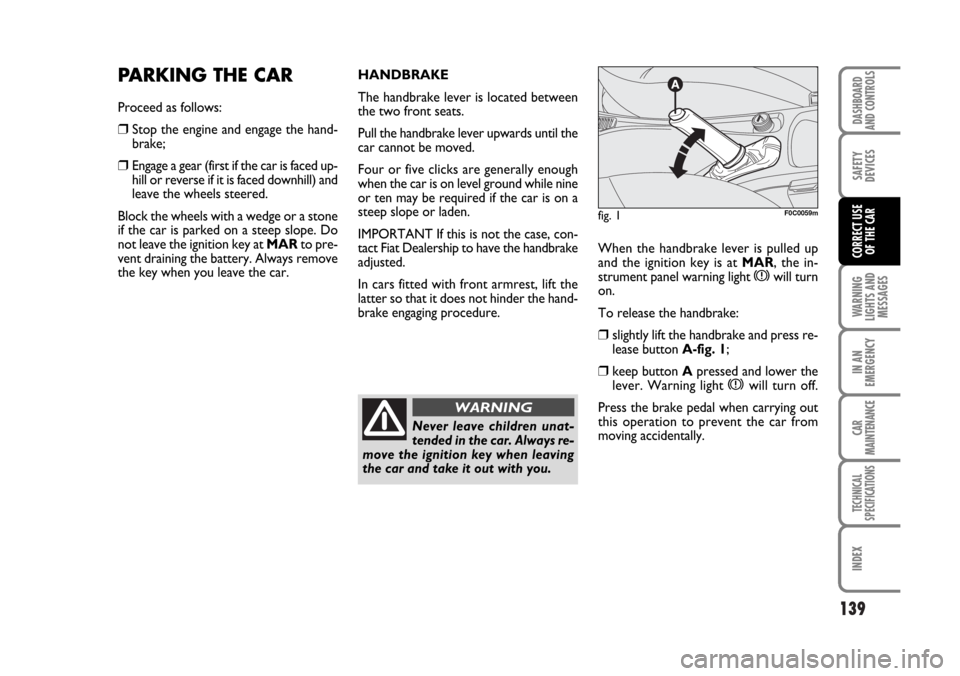
139
WARNING
LIGHTS AND
MESSAGES
IN AN
EMERGENCY
CAR
MAINTENANCE
TECHNICAL
SPECIFICATIONS
INDEX
DASHBOARD
AND CONTROLS
SAFETY
DEVICES
CORRECT USE
OF THE CAR
PARKING THE CAR
Proceed as follows:
❒ Stop the engine and engage the hand-
brake;
❒Engage a gear (first if the car is faced up-
hill or reverse if it is faced downhill) and
leave the wheels steered.
Block the wheels with a wedge or a stone
if the car is parked on a steep slope. Do
not leave the ignition key at MARto pre-
vent draining the battery. Always remove
the key when you leave the car.HANDBRAKE
The handbrake lever is located between
the two front seats.
Pull the handbrake lever upwards until the
car cannot be moved.
Four or five clicks are generally enough
when the car is on level ground while nine
or ten may be required if the car is on a
steep slope or laden.
IMPORTANT If this is not the case, con-
tact Fiat Dealership to have the handbrake
adjusted.
In cars fitted with front armrest, lift the
latter so that it does not hinder the hand-
brake engaging procedure.When the handbrake lever is pulled up
and the ignition key is at MAR, the in-
strument panel warning light
xwill turn
on.
To release the handbrake:
❒slightly lift the handbrake and press re-
lease button A-fig. 1;
❒keep button Apressed and lower the
lever. Warning light xwill turn off.
Press the brake pedal when carrying out
this operation to prevent the car from
moving accidentally.
fig. 1F0C0059m
Never leave children unat-
tended in the car. Always re-
move the ignition key when leaving
the car and take it out with you.
WARNING
Page 141 of 274
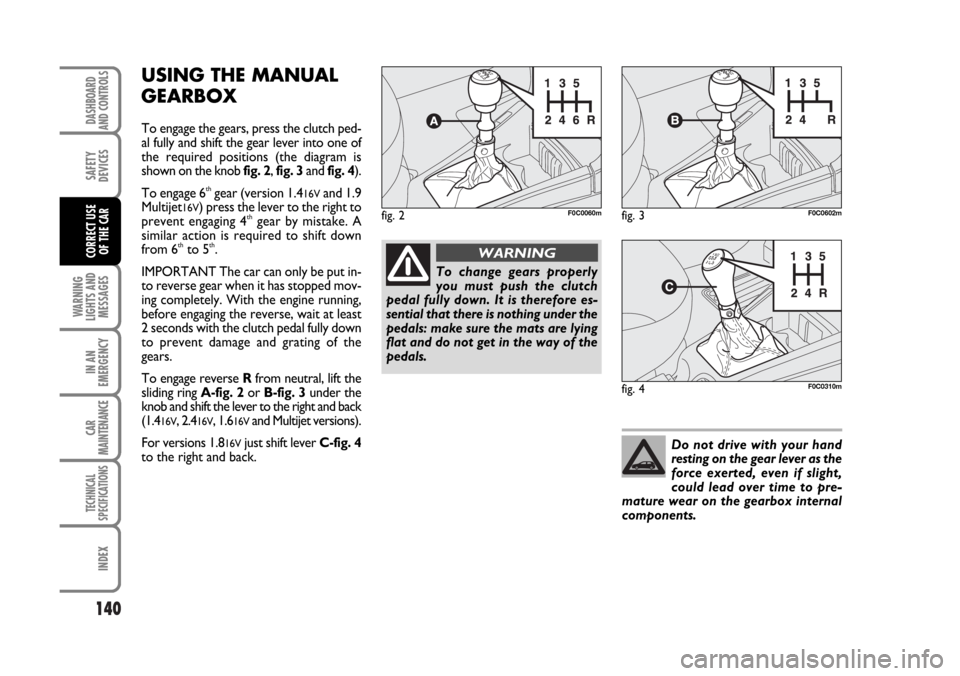
140
WARNING
LIGHTS AND
MESSAGES
IN AN
EMERGENCY
CAR
MAINTENANCE
TECHNICAL
SPECIFICATIONS
INDEX
DASHBOARD
AND CONTROLS
SAFETY
DEVICES
CORRECT USE
OF THE CAR
USING THE MANUAL
GEARBOX
To engage the gears, press the clutch ped-
al fully and shift the gear lever into one of
the required positions (the diagram is
shown on the knob fig. 2, fig. 3and fig. 4).
To engage 6
thgear (version 1.416Vand 1.9
Multijet16V) press the lever to the right to
prevent engaging 4thgear by mistake. A
similar action is required to shift down
from 6
thto 5th.
IMPORTANT The car can only be put in-
to reverse gear when it has stopped mov-
ing completely. With the engine running,
before engaging the reverse, wait at least
2 seconds with the clutch pedal fully down
to prevent damage and grating of the
gears.
To engage reverse Rfrom neutral, lift the
sliding ring A-fig. 2or B-fig. 3 under the
knob and shift the lever to the right and back
(1.4
16V, 2.416V, 1.616Vand Multijet versions).
For versions 1.8
16Vjust shift lever C-fig. 4
to the right and back.
fig. 2F0C0060mfig. 3F0C0602m
fig. 4F0C0310m
To change gears properly
you must push the clutch
pedal fully down. It is therefore es-
sential that there is nothing under the
pedals: make sure the mats are lying
flat and do not get in the way of the
pedals.
WARNING
Do not drive with your hand
resting on the gear lever as the
force exerted, even if slight,
could lead over time to pre-
mature wear on the gearbox internal
components.
Page 142 of 274
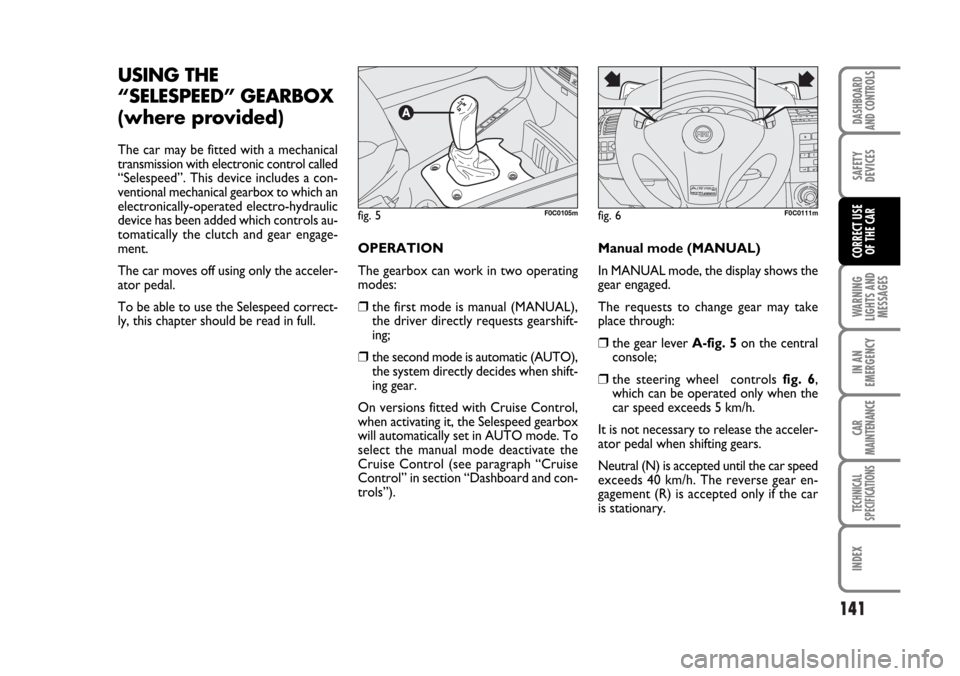
141
WARNING
LIGHTS AND
MESSAGES
IN AN
EMERGENCY
CAR
MAINTENANCE
TECHNICAL
SPECIFICATIONS
INDEX
DASHBOARD
AND CONTROLS
SAFETY
DEVICES
CORRECT USE
OF THE CAR
USING THE
“SELESPEED” GEARBOX
(where provided)
The car may be fitted with a mechanical
transmission with electronic control called
“Selespeed”. This device includes a con-
ventional mechanical gearbox to which an
electronically-operated electro-hydraulic
device has been added which controls au-
tomatically the clutch and gear engage-
ment.
The car moves off using only the acceler-
ator pedal.
To be able to use the Selespeed correct-
ly, this chapter should be read in full. OPERATION
The gearbox can work in two operating
modes:
❒the first mode is manual (MANUAL),
the driver directly requests gearshift-
ing;
❒the second mode is automatic (AUTO),
the system directly decides when shift-
ing gear.
On versions fitted with Cruise Control,
when activating it, the Selespeed gearbox
will automatically set in AUTO mode. To
select the manual mode deactivate the
Cruise Control (see paragraph “Cruise
Control” in section “Dashboard and con-
trols”).Manual mode (MANUAL)
In MANUAL mode, the display shows the
gear engaged.
The requests to change gear may take
place through:❒the gear lever A-fig. 5on the central
console;
❒the steering wheel controls fig. 6,
which can be operated only when the
car speed exceeds 5 km/h.
It is not necessary to release the acceler-
ator pedal when shifting gears.
Neutral (N) is accepted until the car speed
exceeds 40 km/h. The reverse gear en-
gagement (R) is accepted only if the car
is stationary.
fig. 5F0C0105mfig. 6F0C0111m
Page 143 of 274
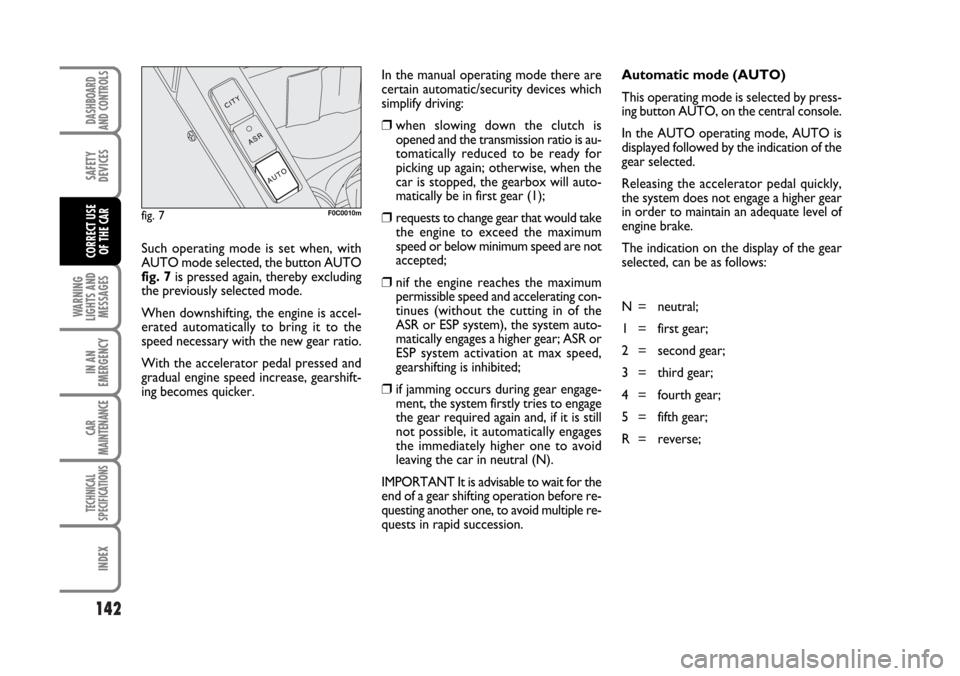
142
WARNING
LIGHTS AND
MESSAGES
IN AN
EMERGENCY
CAR
MAINTENANCE
TECHNICAL
SPECIFICATIONS
INDEX
DASHBOARD
AND CONTROLS
SAFETY
DEVICES
CORRECT USE
OF THE CARSuch operating mode is set when, with
AUTO mode selected, the button AUTO
fig. 7is pressed again, thereby excluding
the previously selected mode.
When downshifting, the engine is accel-
erated automatically to bring it to the
speed necessary with the new gear ratio.
With the accelerator pedal pressed and
gradual engine speed increase, gearshift-
ing becomes quicker.In the manual operating mode there are
certain automatic/security devices which
simplify driving:
❒when slowing down the clutch is
opened and the transmission ratio is au-
tomatically reduced to be ready for
picking up again; otherwise, when the
car is stopped, the gearbox will auto-
matically be in first gear (1);
❒requests to change gear that would take
the engine to exceed the maximum
speed or below minimum speed are not
accepted;
❒nif the engine reaches the maximum
permissible speed and accelerating con-
tinues (without the cutting in of the
ASR or ESP system), the system auto-
matically engages a higher gear; ASR or
ESP system activation at max speed,
gearshifting is inhibited;
❒if jamming occurs during gear engage-
ment, the system firstly tries to engage
the gear required again and, if it is still
not possible, it automatically engages
the immediately higher one to avoid
leaving the car in neutral (N).
IMPORTANT It is advisable to wait for the
end of a gear shifting operation before re-
questing another one, to avoid multiple re-
quests in rapid succession.Automatic mode (AUTO)
This operating mode is selected by press-
ing button AUTO, on the central console.
In the AUTO operating mode, AUTO is
displayed followed by the indication of the
gear selected.
Releasing the accelerator pedal quickly,
the system does not engage a higher gear
in order to maintain an adequate level of
engine brake.
The indication on the display of the gear
selected, can be as follows:
N = neutral;
1 = first gear;
2 = second gear;
3 = third gear;
4 = fourth gear;
5 = fifth gear;
R = reverse;
fig. 7F0C0010m
Page 144 of 274
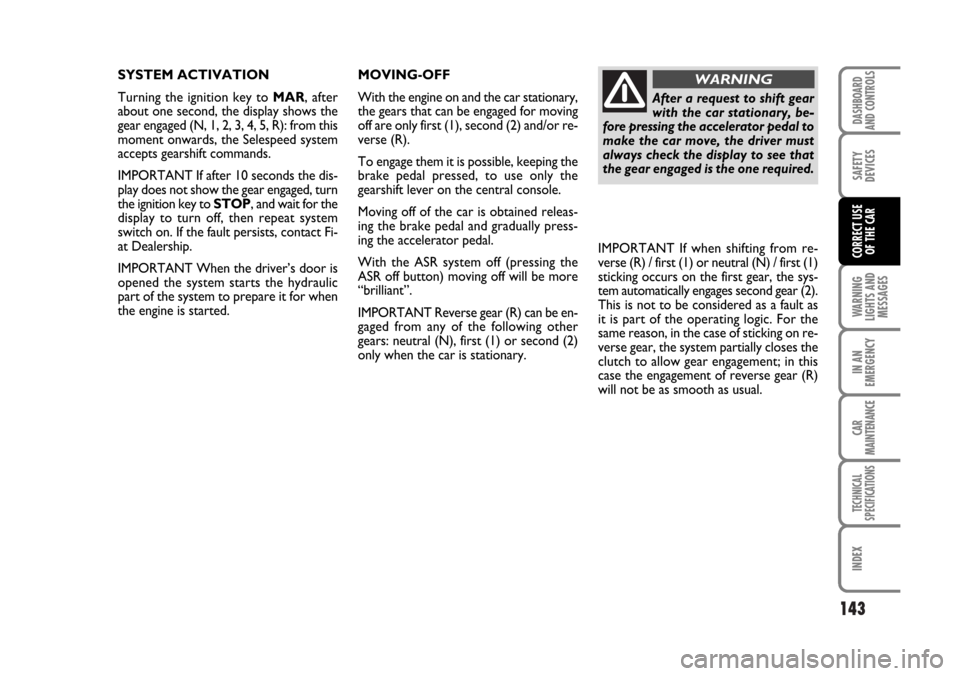
143
WARNING
LIGHTS AND
MESSAGES
IN AN
EMERGENCY
CAR
MAINTENANCE
TECHNICAL
SPECIFICATIONS
INDEX
DASHBOARD
AND CONTROLS
SAFETY
DEVICES
CORRECT USE
OF THE CAR
SYSTEM ACTIVATION
Turning the ignition key to MAR, after
about one second, the display shows the
gear engaged (N, 1, 2, 3, 4, 5, R): from this
moment onwards, the Selespeed system
accepts gearshift commands.
IMPORTANT If after 10 seconds the dis-
play does not show the gear engaged, turn
the ignition key to STOP, and wait for the
display to turn off, then repeat system
switch on. If the fault persists, contact Fi-
at Dealership.
IMPORTANT When the driver’s door is
opened the system starts the hydraulic
part of the system to prepare it for when
the engine is started. MOVING-OFF
With the engine on and the car stationary,
the gears that can be engaged for moving
off are only first (1), second (2) and/or re-
verse (R).
To engage them it is possible, keeping the
brake pedal pressed, to use only the
gearshift lever on the central console.
Moving off of the car is obtained releas-
ing the brake pedal and gradually press-
ing the accelerator pedal.
With the ASR system off (pressing the
ASR off button) moving off will be more
“brilliant”.
IMPORTANT Reverse gear (R) can be en-
gaged from any of the following other
gears: neutral (N), first (1) or second (2)
only when the car is stationary.IMPORTANT If when shifting from re-
verse (R) / first (1) or neutral (N) / first (1)
sticking occurs on the first gear, the sys-
tem automatically engages second gear (2).
This is not to be considered as a fault as
it is part of the operating logic. For the
same reason, in the case of sticking on re-
verse gear, the system partially closes the
clutch to allow gear engagement; in this
case the engagement of reverse gear (R)
will not be as smooth as usual.
After a request to shift gear
with the car stationary, be-
fore pressing the accelerator pedal to
make the car move, the driver must
always check the display to see that
the gear engaged is the one required.
WARNING